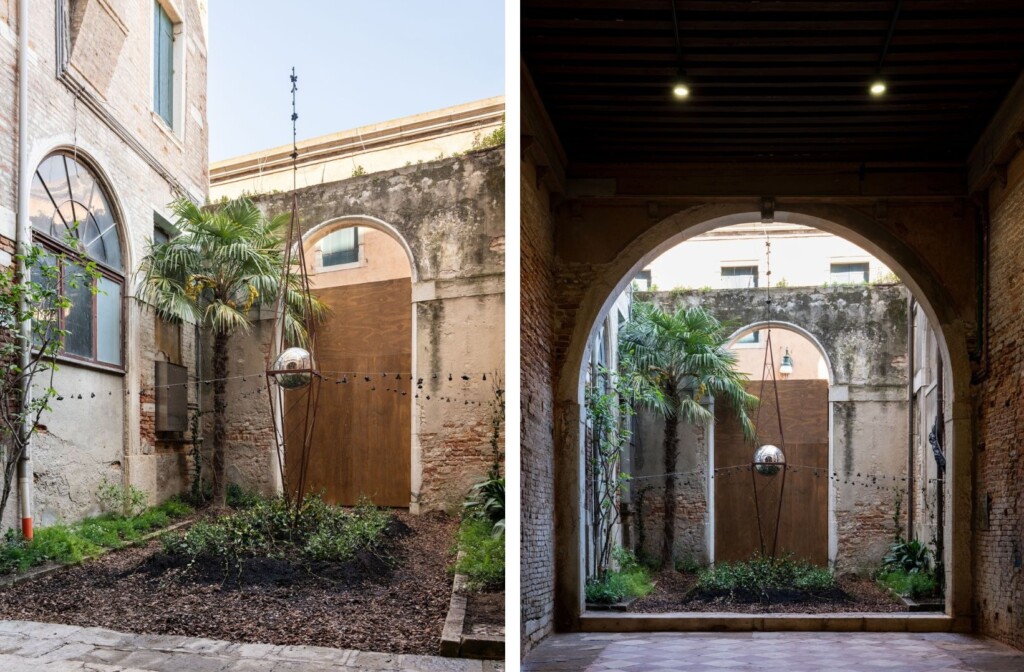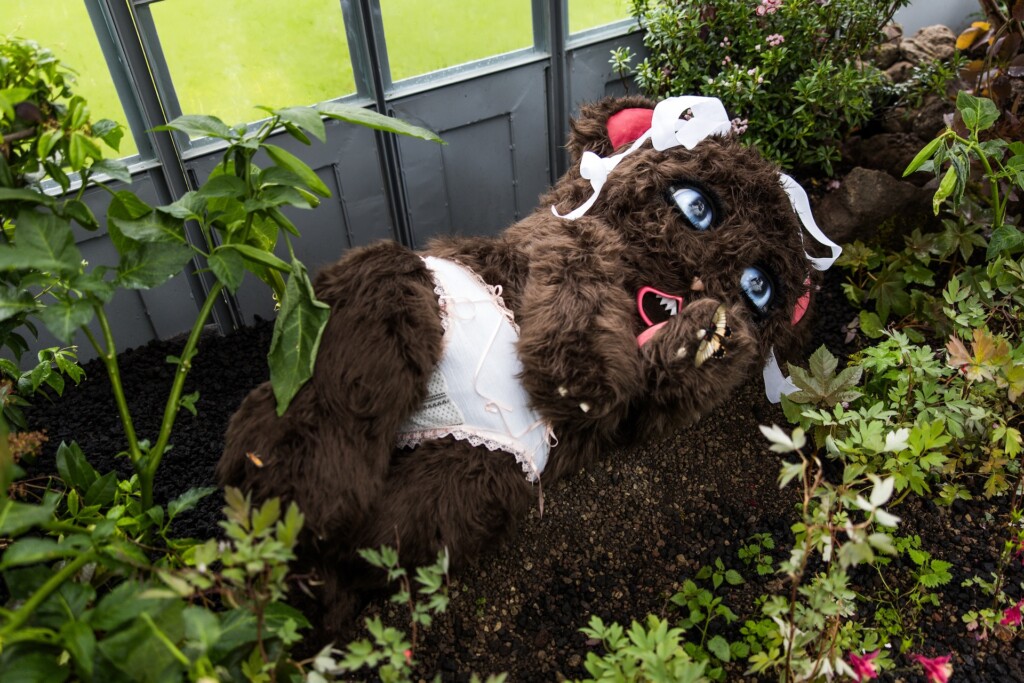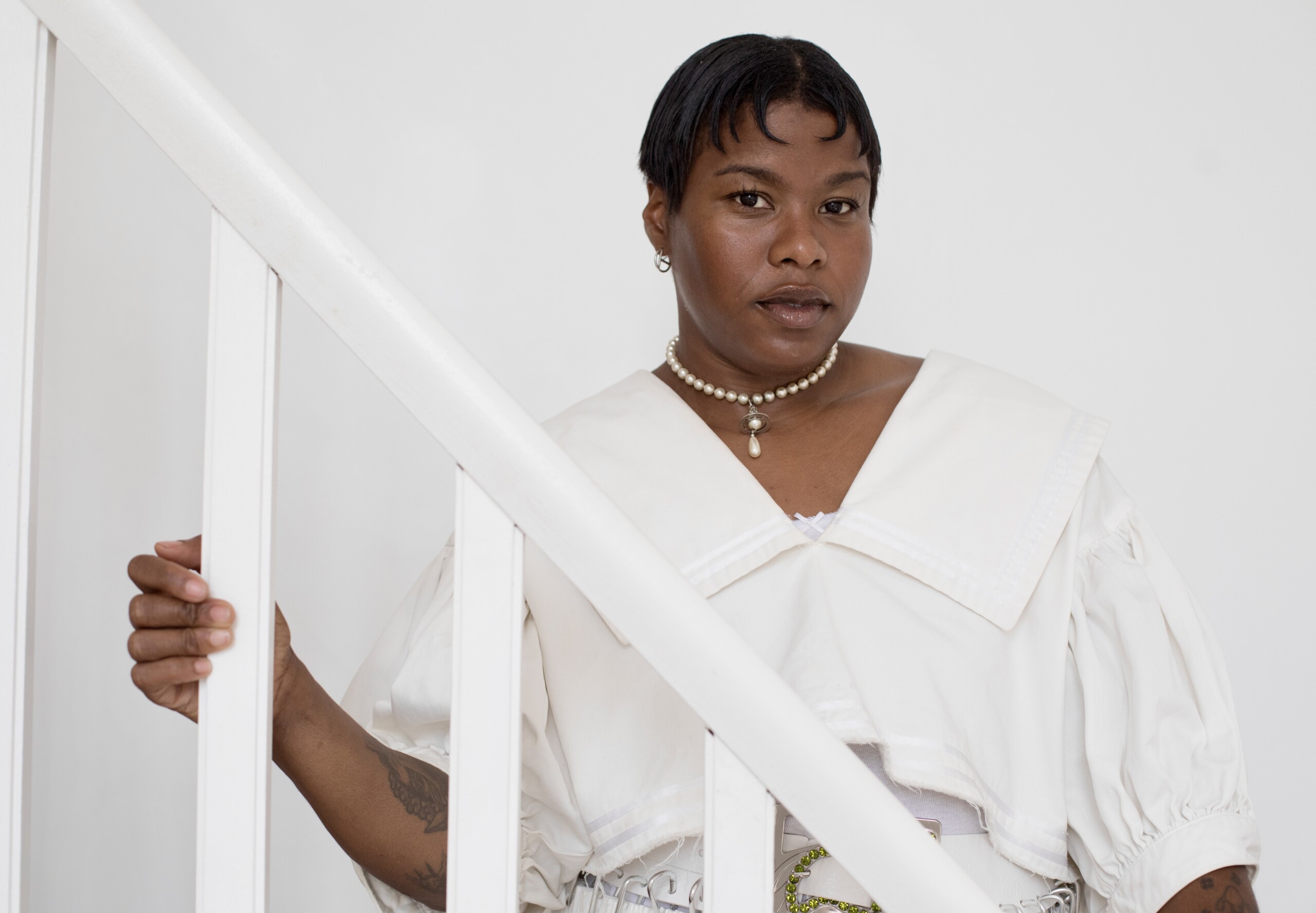Nigerian-American artist and poet Precious Okoyomon (b.1993 in London and lives in New York) talks to us about invasive plant species, co-creation and colonial history, as well as their current work at Fondation Beyeler and the Venice Biennale. We met them in Paris, where they are currently an Art Explora resident at Cité Internationale des arts.
Plants play a hugely important role in your work – as storytellers, historians, healers, threats and memories. What is their role in your current pieces at the Fondation Beyeler near Basel and at the Venice Biennale?
I work a lot with plants that are viewed as invasive, and with poisonous species that you’re not supposed to grow or give attention to, such as bleeding heart flowers, ricin, datura and jasmine. At the Fondation Beyeler near Basel, my piece the sun eats her children (2023) is a nightmare, a poisonous garden in which a teddy bear named Beloved resides with around 200 live butterflies – black swallowtails and blue morphos – that breed and die within the space. The plants are all poisonous to humans but are perfectly safe for the butterflies. I’ve created their paradise, but everything in that space can kill you. This is a space of toxicity and monstrosity, but it allows the plants to be themselves.
For the Nigerian Pavilion at the Venice Biennale, I created a love letter to Lagos, the place of my origin, through a garden space which features a radio tower (Pre-sky / emit light: yes like that, (2024)). For this piece, I went back to Nigeria and interviewed strangers psychoanalytically, asking them the same 10 invasive questions such as ‘who caused the suffering of your mother?’. These questions hack into the unconscious of the city and the pulse of the people. The radio tower transmits continuous-loop frequencies, with the interviews chopped up into one long, never-ending poem with its own frequency of people’s honesty. The garden I made holds the sound, as a non-coercive, discursive movement that’s happening continuously. It’s a space to sit in a collective memory of thought. For me, the collective unconscious is the truest notion of where a place presently is, what the people are dreaming, how everyone’s feeling. I want to create a portal and give people time and space outside of time itself.

Precious Okoyomon, installation view of the sun eats her children (2024), Fondation Beyeler, Riehen/Basel. Courtesy of the artist. Photo: Stefan Bohrer.
Are the gardens you create for your installations, as well as your garden at home, a way to connect and co-create between plant species and you?
Always. That’s the miracle of working with nature and plants. I move towards things that I can’t control and make space for that miracle. A lot of magic happens and I co-create with my gardens. I only plant the seeds, collect and pollinate. Whatever springs out teaches me. I’ve grown so much from making so many gardens. You don’t make gardens on your own – I work with seed libraries and I’ve met many people, landscapers and gardeners who have taught me new ways of adapting. In my own garden at home I grow from seeds that I’ve gotten from the people I’ve met. It’s a non-discursive practice that moves me and inspires growth. Plants and people teach me about new plants and new people, and there is this forever growth inside an endless poem.
My general connection is that humanity isn’t separate from nature – I grew up with that singular notion of spirit. I see it as a pollinating ethos of thought – we actively have to practise how we relate to the environments around us, how we view the natural world. Criticising invasive species as being indigenous to only one space isn’t how the natural world moves. It’s not separated, everything is entangled. Time is nature – how do we understand and flow with our world in a way that makes sense for our present? That’s why a lot of the spaces I make explore time and memory.

Precious Okoyomon, installation view of Pre-sky / emit light: yes like that (2024), ‘Nigeria Imaginary’, La Biennale di Venezia. Courtesy of the artist and the Museum of West African Art Photo: Marco Cappelleti Studio.
You explore the idea of entanglements and how these plants have moved across the world with us through globalisation and colonialism. How can ecology help us understand colonial history?
It’s an interesting mirror to look through, and one that reflects us perfectly. I work with plants such as kudzu which was brought over to the US to cover the environmental impact of growing cotton during slavery, as well as sugarcane which essentially funded the transatlantic slave trade. These plants work with us – they contain histories of migration. They’re brought over, and have their own memory which works into our soil and space. Colonisation isn’t separate from the natural world. The more we understand what our soil teaches us, and how we can adapt to that, the more a shift can be created.
I’m currently working on a garden at Cornell University with soil scientists and botanists. People still have an archaic view of invasive plants, with a lot of hatred and misunderstanding. I view this as a colonial practice of being rooted in the idea that you own the land and you can control what happens to it. I want to work with the plants, working with the place you are in. You also need to know the people around you to change the environment. It’s literally soil work.

Precious Okoyomon, installation view of the sun eats her children (2024), Fondation Beyeler, Riehen/Basel. Courtesy of the artist. Photo: Stefan Bohrer.
You are currently an Art Explora resident artist at the Cité internationale des arts in Montmartre. How are you finding Paris and what are you currently working on?
I’m absolutely loving its rhythm. I feel nourished, it’s allowing me to have space to think. I’m beginning a new body of work that’s different from everything I’ve made previously, and I’m allowing myself to dream into that space with the utmost freedom. It can be hard to find space and rhythm in New York. Being in Paris is different, I’m obsessed and I feel very productive.
Who inspires you? How would you like to inspire through your role as an artist?
My mom taught me how to be an artist and how to see people, which I think is an artistic practice of witnessing. A lot of writers are also a huge inspiration to me, like Saidiya Hartman, psychoanalyst Bracha Ettinger, philosopher Denise Ferreira da Silva, as well as artists such as Otobong Nkanga who is on the same vibrational frequency as me. But poets are where I hold my heart. Dana Ward inspires me to find time in the world. And Alice Notley, an amazing poet who lives in Paris, is a guiding light for me. Poets are artists. Words are magic. And poetry is not a luxury.
My artistic practice is rooted in my poetry which is a translation of moments and the way I move in the world, which comes from a practice of relational care. I feel like my responsibility in the world is to care for and witness people in a way that is transformative and radical, and whatever comes from that is enough. The exhibitions and spaces I make are also practices of care – for the plants, the animals that live inside those worlds, for people. Those kinds of spaces create time outside of time for people to gather and just be. That’s the practice of holding. I want to give the energy of time and space to people. That’s all I’m ever trying to explore.
Precious Okoyomon, the sun eats her children (2023) is currently on show at Fondation Beyeler, near Basel, as part of the group exhibition ‘I Can’t Tell If This Longing Is My Own‘, until 11th August 2024.
Precious Okoyomon, Pre-sky / emit light: yes like that (2024) is currently on show at the Nigerian Pavilion, ‘Nigeria Imaginary‘, as part of the 60th International Art Exhibition, La Biennale di Venezia, until 24th November 2024.
Author: Eliza Morris
July 2024
Cover: © Jérôme Mizar for Art of Change 21, July 2024, Art Explora Residency, Cité Internationale des Arts, Paris
Impact Art News, June-July 2024 #49

